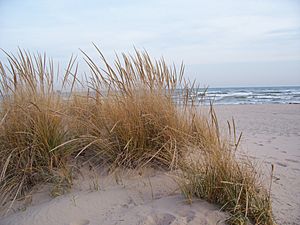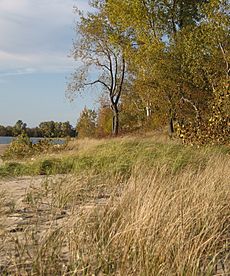American beachgrass facts for kids
Quick facts for kids American beachgrass |
|
|---|---|
 |
|
| American beachgrass in Kohler-Andrae State Park on Lake Michigan in November; note the seed heads rising above the leaves. | |
| Scientific classification | |
| Genus: |
Ammophila (plant)
|
| Species: |
breviligulata
|
American beachgrass (also called American marram grass) is a special type of grass. It grows naturally in eastern North America. You can find it on sandy dunes along the Atlantic Ocean and Great Lakes coasts. This tough grass loves places where sand is always moving and the winds are strong. It's super important because it helps build the first sand dunes right by the coast. These dunes protect the land behind them.
American beachgrass doesn't grow well in sand that stays still. You usually won't find it far from the coast. On the Atlantic coast, it grows as far south as North Carolina. People often plant it to help fix damaged dunes. In the 1930s, American beachgrass was brought to the Pacific coast of North America. There, it has become an "invasive" plant, meaning it spreads and takes over. It's now a big part of how coastal areas are changing in Oregon, Washington, and British Columbia.
What is American Beachgrass?

American beachgrass is a plant that lives for many years. It has a huge system of underground stems called rhizomes. These rhizomes help the plant spread out. Its leaves have deep grooves on top and are smooth underneath. They can grow to be about 1 to 3 feet (0.3 to 0.9 meters) tall.
The plant's flower part is a spiky cluster called a panicle. This panicle can grow up to 10 inches (25 centimeters) long. Each tiny flower is single and doesn't have a bristly tip (called an awn). The seed heads usually show up in late July or August. The scientific name breviligulata comes from Latin words. Brevis means "short" and ligula means "tongue." This refers to a small flap on grass leaves called a ligule.

American beachgrass looks a lot like another type of beachgrass, Ammophila arenaria (European beachgrass). But there are some small differences. American beachgrass has shorter ligules (1–3 mm) compared to European beachgrass (10–30 mm). Its leaves are also wider and don't roll up as much. Its flower spike is longer (25–35 cm) than the European type (15–25 cm). Also, the veins on the top of its leaves are scaly, not fuzzy.
How Does Beachgrass Help the Environment?
Both American and European beachgrass are known for growing on stable sand dunes. When these grasses are planted in new places, they quickly build the first line of dunes, called foredunes. These plants spread fast, about 6 to 10 feet (1.8 to 3 meters) each year. They do this using their underground stems (rhizomes). Each plant clump can grow up to 100 new stems every year!
Beachgrass can survive even if it gets buried under 3 feet (0.9 meters) of sand. Being buried actually helps the rhizomes grow upwards, which makes the plant stronger. Beachgrass is also a great example of a xerophyte. This means it can live in very dry or semi-dry places like beach dunes. The plant has ways to deal with heat and strong winds. Its long, narrow leaves can roll or fold up. The rough top surface of the leaf, where the plant breathes, can turn away from the wind.
Beachgrass is often the main plant on foredunes. Sometimes, it's the only plant you'll find there. But it doesn't grow as well just a few feet away from the coast. This is a bit of a mystery. Why would a plant that's so good at growing on foredunes struggle just a little further inland? Scientists have studied this. They found that Ammophila species can be harmed by tiny living things in the soil, like nematodes (a type of worm). There aren't many of these tiny worms in fresh sand. But they build up in the roots of beachgrass in sand that doesn't move much. This means beachgrass mostly stays on the foredunes it builds. These dunes are right by the water's edge, where sand is often moved around.
Around the Great Lakes, American beachgrass only grows in active sand dune areas along the shores. It is considered a threatened species in Minnesota. This is where it reaches the most western part of its natural range, near Duluth.
Why is American Beachgrass Invasive?
Starting in the 1800s, European beachgrass (A. arenaria) was brought to the Pacific coast of North America. It was used to help control beach sands. It did this job so well that it is now considered an "invasive" plant. This means it spreads widely and can harm native plants and ecosystems. It's invasive not only on the Pacific coast (from California north to British Columbia) but also on many other coasts worldwide where it was introduced. European beachgrass built foredunes that were usually about 14 feet (4.3 meters) high. This was much taller than the dunes built by the native dune grass, Leymus mollis.
In the 1930s, American beachgrass (A. breviligulata) was planted on about 3,000 acres (1,200 hectares) in Oregon. Since then, American beachgrass has slowly replaced European beachgrass in Oregon and Washington. Scientists aren't sure exactly why American beachgrass has been more successful.
One clear change is that the foredunes built by American beachgrass are shorter. They are about 9 feet (2.7 meters) high in this area. The number of other plant species that grow with mature American beachgrass is similar to those that grow with European beachgrass. However, because the dunes are shorter, coastal areas that had gotten used to the tall European beachgrass dunes are now changing again. This is especially true for areas just behind the foredune that used to be protected by the taller dunes. Also, buildings and roads that were built assuming the tall European beachgrass dunes would keep protecting them might now be at risk from shifting sand and more exposure to wind and water during storms.

